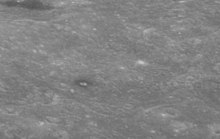Neujmin (crater)
 | |
| Coordinates | 26°41′S 125°10′E / 26.68°S 125.17°E |
|---|---|
| Diameter | 97.03 km (60.29 mi) |
| Depth | 3.5 km (2.2 mi)[1][2] |
| Colongitude | 236° at sunrise |
| Eponym | Grigory N. Neujmin |



Neujmin is a lunar impact crater on the Moon's far side. It is nearly attached to the west-southwest of the smaller crater Waterman, and lies to the southwest of the prominent Tsiolkovskiy.
This is an eroded crater formation that has been somewhat deformed by subsequent impacts. The circular crater Neujmin P lies across the southwestern rim. There are multiple small craterlets along the northwestern rim and inner wall, most likely secondary impacts from Tsiolkovskiy, and both the northern and southern rims are disrupted.
There is a dark-halo crater on the floor of Neujmin, which typically indicates that darker material, such as mare lava, exists below the present surface.
The crater was named after Soviet astronomer Grigory N. Neujmin by the IAU in 1970.[3]
Satellite craters
[edit]By convention these features are identified on lunar maps by placing the letter on the side of the crater midpoint that is closest to Neujmin.
| Neujmin | Latitude | Longitude | Diameter |
|---|---|---|---|
| P | 28.5° S | 124.2° E | 38 km |
| Q | 30.0° S | 121.8° E | 17 km |
| T | 27.1° S | 122.0° E | 24 km |
See also
[edit]- 1129 Neujmina, asteroid
References
[edit]- ^ LTO-101C2 Waterman, Lunar Topographic Orthophotomap (LTO) Series, Publisher: Defense Mapping Agency, Scale: 1:250,000.
- ^ LTO-101C1 Neujmin, Lunar Topographic Orthophotomap (LTO) Series, Publisher: Defense Mapping Agency, Scale: 1:250,000.
- ^ Neujmin, Gazetteer of Planetary Nomenclature, International Astronomical Union (IAU) Working Group for Planetary System Nomenclature (WGPSN)
- Andersson, L. E.; Whitaker, E. A. (1982). NASA Catalogue of Lunar Nomenclature. NASA RP-1097.
- Blue, Jennifer (July 25, 2007). "Gazetteer of Planetary Nomenclature". USGS. Retrieved 2007-08-05.
- Bussey, B.; Spudis, P. (2004). The Clementine Atlas of the Moon. New York: Cambridge University Press. ISBN 978-0-521-81528-4.
- Cocks, Elijah E.; Cocks, Josiah C. (1995). Who's Who on the Moon: A Biographical Dictionary of Lunar Nomenclature. Tudor Publishers. ISBN 978-0-936389-27-1.
- McDowell, Jonathan (July 15, 2007). "Lunar Nomenclature". Jonathan's Space Report. Retrieved 2007-10-24.
- Menzel, D. H.; Minnaert, M.; Levin, B.; Dollfus, A.; Bell, B. (1971). "Report on Lunar Nomenclature by the Working Group of Commission 17 of the IAU". Space Science Reviews. 12 (2): 136–186. Bibcode:1971SSRv...12..136M. doi:10.1007/BF00171763. S2CID 122125855.
- Moore, Patrick (2001). On the Moon. Sterling Publishing Co. ISBN 978-0-304-35469-6.
- Price, Fred W. (1988). The Moon Observer's Handbook. Cambridge University Press. ISBN 978-0-521-33500-3.
- Rükl, Antonín (1990). Atlas of the Moon. Kalmbach Books. ISBN 978-0-913135-17-4.
- Webb, Rev. T. W. (1962). Celestial Objects for Common Telescopes (6th revised ed.). Dover. ISBN 978-0-486-20917-3.
- Whitaker, Ewen A. (1999). Mapping and Naming the Moon. Cambridge University Press. ISBN 978-0-521-62248-6.
- Wlasuk, Peter T. (2000). Observing the Moon. Springer. ISBN 978-1-85233-193-1.
